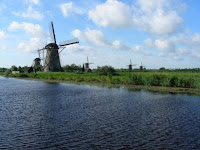On thursday last week I've been to the 'Neues Museum' ('New Museum') or shortly 'nm' in Nuremberg. There is an exhibition about German design, called "design deutschland. case study 08" ("german design. case study 08") which will be displayed there until 5th October 2008. Now I, personally, think that this regional fixation sounds a little odd at the first moment. The guide (a guidance through the exhibition was included in the visit) told us that he also finds this name a little distracting for the visistor in first place. Thing is: There is no such thing as 'typical German design'. The curator's idea was to find objects and goods from our day to day life, which are designed by people living in Germany or are being produced by German companies. Another criteria the specific objects had to fulfil to get enlisted was that they are still being produced and
sold.
Start of the tour was at about 6:30 PM. First there were some words about the 'nm' itself, the building being designed by architect Volker Staab and built in 1999, so it is a fairly new building as ist the design. Our guide explained some facts about the building, like how it acutally was designed and that the basic geometrical element the architect used are two cubes, one up in the air and a second one going down into the ground, resulting in the building being as tall as deep. One thing I relly like about the architecture of the 'nm' are its really big front windows. The front of the entire building is fully transparent glass, allowing passing pedestrians to take a peak inside the museum from the outside. At the moment there is also a really big picture (about three or four meters high) of a girl by Julian Opie in the second floor window looking outside at you! Quite impressive. Pictures of the great architecture can be found on the museums website.
Once you entere the exhibition you find out that the name 'case study' is a wordplay. The different objects displayed are being presented in big wooden cases, each about six or seven meters long and about 3 meters in width. The exhibition contains a total of five of these cases, each one displaying different objects from certain parts of our daily life. The five different cases are divided in 'tools', 'position', 'function', 'material' and 'system'. Sadly you were not allowed to take pictures.
There were products of all kinds, chairs, lamps, a table, a hammer, a wineshelf and so on. I really enjoyed these random looking arangements of objects. Another thing that surprised me, that there were designs from really different epochs. There was a brand new chair, it's design is from 2008 sitting next to a salt & pepper shaker set by WMF which dates back to 1953 (remember this ist still being sold!). There also were really artistic designs, like a chair by Konstantin Grcic, letting the product look more like a piece of art whether a day to day furniture and other designs being not artistic at all, but were included into the collection because they integrated themselves so perfectly into the daily vocabulary. One good example for this is the high-pressure steam cleaner by the German company 'Kärcher'. It's design is nothing special, actually it is just a boxy thing, but its presence is so pmnipresent, that the company name has become a synonym for high-pressure steam cleaners.
Of couse the visitors' impressions where quite different. Some praised the objects displayed and said how much they liked the look of them. Others said things like "well this is no really well designed thing" or "this is no art", immediately leading to a discussion about the difference between design and art, but that is another story. I really enjoyed the exhibition and I also collected all of the leaflets with the manufacturers' homepages. I'm afraid thogh, they are all in German only, but maybe you can find something about it here. This page is credit of the German Design Council, who is responsible for the exhibition and already has an entry for case study 08, just the link is offline at the moment I am writring this.
Well, I'll check a few prices of these highly regarded peaces, maybe I will furnish up my flat with some famous designer objects shown in the museum.










